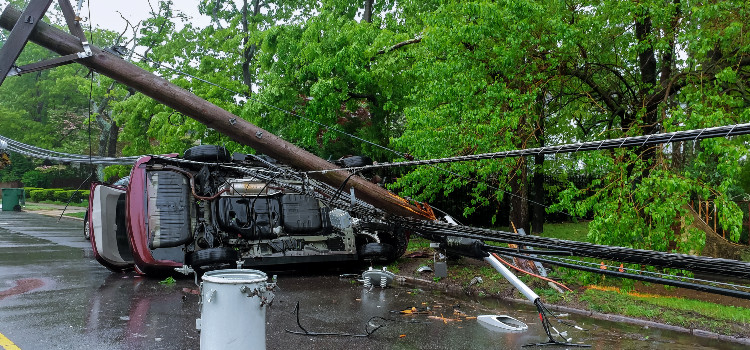Looking for more information on storm surges? We did a deep dive into the subject here.
What is storm surge in a hurricane?
A storm surge is the sea level rise that occurs during storms, which may lead to flooding. The term usually refers to the rise of water above normally dry land areas near and on shorelines. Storm surges can happen anywhere, even where there are no tropical cyclones or hurricanes present.
Their size and inundation level varies greatly from storm to storm, due to differences in atmospheric pressures, tidal ranges and local geography. Storm surges have been observed even in small tropical storms that get little or no press coverage.
Contents
What Causes A Storm Surge In A Hurricane?
Storm surges are caused by the interaction of wind and waves. The force exerted by the wind on a coastal area is greater than the force exerted by the waves. Wind can blow toward a coast, or away from a coast.
Winds around a storm center may blow water away from a coastline, but storms may also increase, or intensify as they move closer to coasts. They can bring tropical storm-force winds well inland from their centers, leading to damaging storm surge. Storm surge is not an inevitable consequence of a hurricane or any other kind of storm.
Storm Surge Basics On The Rise
Storm surge is typically defined as the total of two components: the water level rise which occurs as the surface level rises due to atmospheric air pressure changes, plus extra water added due to wave setup and movement on top of the storm surge. This wave setup effect is caused by interaction between waves and wind, which can be particularly strong during hurricanes.
Storm surge is measured in feet above the mean sea level. The phenomenon can be described in terms of either vertical or horizontal movement. The cumulative water level rise is the sum of wave setup and storm surge, often measured in terms of the specific areas inundated by storm surge.
The high water mark—the highest point on land where the seawater has reached—may provide an indication of storm surge levels during a storm event. In general, storm surge is most damaging when it is accompanied by a high storm tide.
When Will Storm Surge Occur In A Hurricane?
Storm surge can occur during or after a storm has passed, depending on whether the winds have changed directions. This type of storm surge is most common along coasts that are subject to hurricanes and tropical storms. Storm surge can also occur due to tsunamis and flooding caused by other types of severe weather systems, such as monsoons or winter storms under certain conditions.
Storm surge can be highly variable and can occur at any time during or after a storm. It is usually measured as the “incremental rise of water above mean sea level.”
Storm surges can occur at any time during a storm, but probably occur more frequently after the storm has moved through and weakened. Sea level change due to storm surge is measured in feet above mean sea level (MSL) or elevation.
Storm surge is considered to be generally worse when it is accompanied by a high tide. The combination of the two is worse than either alone. Storm surge can also cause or enhance coastal erosion.
How Long After A Hurricane Is The Storm Surge?
Storm surge is likely to occur after the storm has moved on, especially if the storm’s winds have weakened. Storm surge may also occur during the night or early hours of any day, as tides rise overnight or during astronomical high tides.
Storm surge is a factor that increases coastal erosion and sediment movement. While it may be less damaging to a coastline that already suffers from coastal erosion, it can increase the level of harm caused by a coastal area that is experiencing a gradual loss of elevation due to natural processes.
What Side Of A Hurricane Has The Highest Storm Surge?
The side that has the highest storm surge level may vary based on the direction of the wind. As hurricanes make landfall, they bring large waves with them. Winds blowing in toward land can cause water to build up against the coast.
Sometimes, hurricane winds are more intense on one side of a storm than another. This means that one side of a storm can have higher storm surge than another. As storms move directly over coastal areas, they may increasingly cause wave action to push water toward the coast line, thanks to strong winds.
What Is The Storm Surge In A Category 5 Hurricane?
A tropical cyclone’s ability to generate a storm surge is dependent upon the strength of the hurricane. For instance, a Category 5 hurricane will typically cause greater damage than any other category due to its high wind speeds. Within this category, however, there are hurricanes that may cause more destruction than others.
Typically though, you can expect a surge of 20 to 25 feet.
Hurricanes that form in warmer waters tend to bring more rainfall, which can result in devastating flash floods.
What Types Of Locations Are Most Prone To Storm Surges?
Storm surges are most common along coastlines that are prone to hurricanes, tropical storms and other types of severe weather systems. The shorelines most frequently impacted by storm surge include: Florida, Texas (with exceptions of cities like San Antonio), Louisiana, Alabama, the state of Mississippi, the South Carolina, North Carolina, and the Northeast.
Storm surges are rare along the west coast of the United States, but are increasing due to rapid population growth there, construction of artificial land features, tectonic activity and sea level rise.
What Affects The Size Of Storm Surges?
Storm surge can be highly variable and can occur at any time during or after a storm. It is usually measured as the “incremental rise of water above mean sea level. Storm surges can occur at any time during a storm, but probably occur more frequently after the storm has moved through and weakened.
Storm surge is considered to be generally worse when it is accompanied by a high storm tide. The combination of the two is worse than either alone. Storm surge can also cause or enhance coastal erosion.
Is 30 Miles Inland Safe From A Hurricane?
The hurricane zone is exactly 30 miles inland from the coast. The hurricane zone is approximately 60 miles offshore. The “eye” of the hurricane will generally be 5 miles inland.
There are no specific recommendations for how close or far you, your family or your home should be from the shoreline during these types of storms.
Storm Surge Examples
There are many storm surge examples, but the most famous one that people are generally familiar with is probably the storm surge that occurred after major Hurricane Katrina in 2005. This storm surge was over 10 feet (3 meters) in some areas of New Orleans, Louisiana. It killed at least 1,500 people and caused massive amounts of damage. A storm surge of this magnitude could not have been predicted by any kind of forecast model before it happened.
Hurricane Katrina also caused billions of dollars in damage in a particularly vulnerable area of the U.S., due to its location and the basic layout of the city. Storm surges can have a devastating impact on a coastline, even when people aren’t directly in harm’s way. In many cases, people may not realize there is a threat until it is too late.
Storm Surge And Hurricane Damage
A storm surge can cause catastrophic damage anywhere along a coast, even if it is far from the center of the storm. Storm surge may help to carry debris and pollutants into coastal areas that may not otherwise be affected by contact with a tropical cyclone.
Because of this phenomenon, some scientists think that the level of property damage caused by a hurricane may depend on where it makes landfall and how it interacts with sea level and topography over time. During a storm, the highest storm surge may occur near the coast, as ocean water is pushed to the shore by stronger wind speeds and higher waves.
Hurricane damage can be a result of a wide range of factors, including storm surge. In some cases, hurricanes may cause more damage because they move past areas that are more prone to flooding. Storm surge underestimates damage in some cases, as it only accounts for the rise in elevation of the resulting surface waters.
Storm surge can have a huge impact if it occurs shortly after a storm makes landfall. Storm surge may cause enormous amounts of coastal erosion, even if the storm itself does not directly hit the coastline.
Conclusion
A hurricane storm surge is a very serious concern for the people of coastal areas. It can have an enormous impact on homes, businesses, transportation systems, ecosystems and more. If you are in the right location during a hurricane, storm surge will not affect you. But if you are not in an area where flooding is likely to occur, it’s important to be prepared so that you can take precautions in case that happens.

